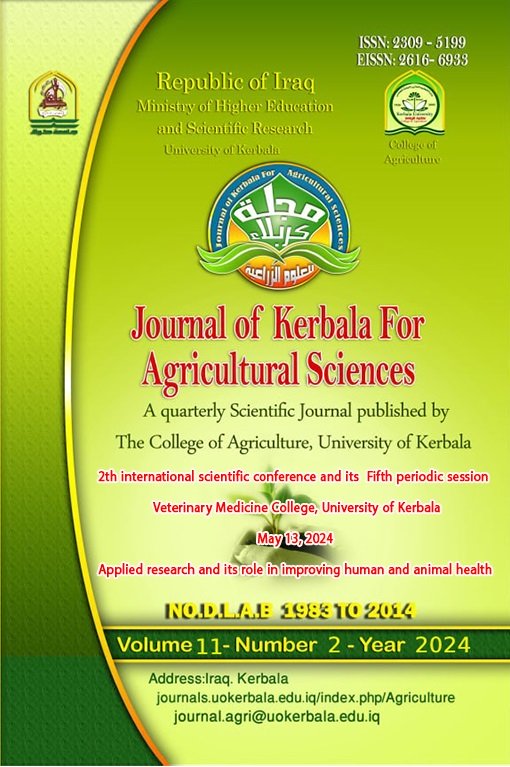Study about environmental naturally fungi infection in pet animals with experimental study
DOI:
https://doi.org/10.59658/jkas.v11i2.2066Keywords:
Rodent, mycosis, domestics animalsAbstract
The current study was designed to investigate Environmental and natural fungi infection in pet animals and then experimentally to study fungi effects on tissues. Naturally infectious samples were fifty swabs in different pet animals (dogs, cats, rats, pigeons, and chickens) from the veterinary hospital of Eden Square in January 202. The findings were Cladosporum spp at (16%) ; Aspergillus flavus, Aspergillus niger at (14%); Rhizopus spp at (8%); Aspergillus ochraceus, Aspergillus terreus, and Penicillium chrysogenum at (6%); Chrysosporium spp, and Cryptococcus neoformans at (4%); Aspergillus fumigatus , Aspergillus ustus and Fusarium spp at (2%) in percentage with other unknown fungi. In doge, only 9 (9/50) samples of fungi, mainly Aspergillus flavus at (33.3%) with cladogram spp.at (22.3%). In cats, also 9 (9/50), mainly Penicillium spp at (22.25 %). In wild rats, fifty cotton swabs showed 12 (12/50) mainly Aspergillus niger, besides Rhizopus spp. At (25%). While in pigeons, only 10 (10/50), mainly Aspergillus niger, Cladosporum spp., and Cryptococcus neoformans at (20%). In chicken, only 5 (5/50), mainly Aspergillus ochraceus at (40%). Fifty albino mice aged 6-8 weeks and 25± 3gm body weight. They were separated in plastic cages and kept for adaptation at 2-3 weeks in the Animal House of the College of Veterinary Medicine, and they were fed standard pellets and water. These animals were divided into 5 groups containing 10 mice each: 1st one: control group treated with normal saline; 2nd Group infected with 0.1ml of Aspergillus flatus intraperitoneally; 3rd group infected with Aspergillus ochraceus 0.1ml intraperitoneally (IP); 4th group infected with 0.1ml Aspergillu niger IP; 5th group mice infected with Cryptococcus neoformans 0.1ml IP at single dose. After 3 weeks animals were scarified. Histopathological examination, in general, reports high incidences of necrotic lesions with granuloma and severe destructive changes, mainly in areas containing fungi hyphae that appear very clearly enclosed to necrotic and inflammatory foci, lung tissues suffering from prominent interstitial pneumonia with thick exudation, mainly fibrinous type. Liver tissues show massive necrosis with Kupfer cells and other inflammatory cell proliferation and evidence of apoptosis. Kidney samples appear with heavy degenerative changes ranging from swelling tubules to necrosis associated with severe inflammation caused by pyelonephritis and phlebitis. also, we saw fungi in the affected area. Spleen shows severe depletion and megakaryocyte proliferation and necrotic lesion. Fungi naturally infects occurs in pet animals and can transmitted to other animals in different environmental; area and can causes severe pathological lesions.
Downloads
Published
How to Cite
License
Copyright (c) 2024 Journal of Kerbala for Agricultural Sciences

This work is licensed under a Creative Commons Attribution 4.0 International License.
Licensing Terms
All articles are published under a Creative Commons License and will be directed to the Creative Commons Attribution 4.0 International License That permits use, distribution, and reproduction in any medium, provided the original work is properly cited and is not used for commercial purposes.
Use by non-commercial users
For non-commercial and non-promotional purposes individual users may access, download, copy, display, and redistribute the articles to colleagues, as well as adapt, translate, text- and data-mine the content subject to the following conditions:
- The author's moral rights are not compromised. These rights include the right of "paternity" (also known as "attribution" - the right for the author to be identified as such) and "integrity" (the right for the author not to have the work altered in such a way that the author's reputation, or integrity may be impugned).
- Where content in the article is identified as belonging to a third party, it is the obligation of the user to ensure that any reuse complies with the copyright policies of the owner of that content.
- If article content is copied, downloaded, or otherwise reused for non-commercial research and education purposes, a link to the appropriate bibliographic citation (authors, journal, article title, volume, issue, page numbers, DOI, and the link to the definitive published version on JKAS website) should be maintained.
- Copyright notices and disclaimers must not be deleted.
- Any translations, for which a prior translation agreement with JKAS has not been agreed, must prominently display the statement: "This is an unofficial translation of an article that appeared in an FSP publication. The publisher has not endorsed this translation."
Use by commercial "for-profit" organizations
Use of JKAS Open Access articles for commercial, promotional, or marketing purposes requires further explicit permission from JKAS (journal.agri@uokerbala.edu.iq) and will be subject to a fee.
The commercial purposes include:
Copying or downloading of articles, or linking to such articles for further redistribution, sale, or licensing; Copying, downloading, or posting by a site or service that incorporates advertising with such content; The inclusion, or incorporation of article content in other works, or services (other than normal quotations with an appropriate citation) that is then available for sale or licensing, for a fee (for example, a compilation produced for marketing purposes, inclusion in a sales pack); Use of article content (other than normal quotations with appropriate citation) by for-profit organizations for promotional purposes; Linking to article content in e-mails redistributed for promotional, marketing or educational purposes; Use for the purposes of monetary reward by means of sale, resale, license, loan, transfer or other form of commercial exploitation such as marketing products; Print reprints of articles can be purchased from journal.agri@uokerbala.edu.iq.
Permissions
- No special permission is required to reuse all, or part of the article published by JKAS, including figures and tables for non-commercial purposes.
- Any part of the article may be reused, for non-commercial purposes, without permission provided that the original article is cited.
- Reuse of an article does not imply endorsement by the authors, JKAS

